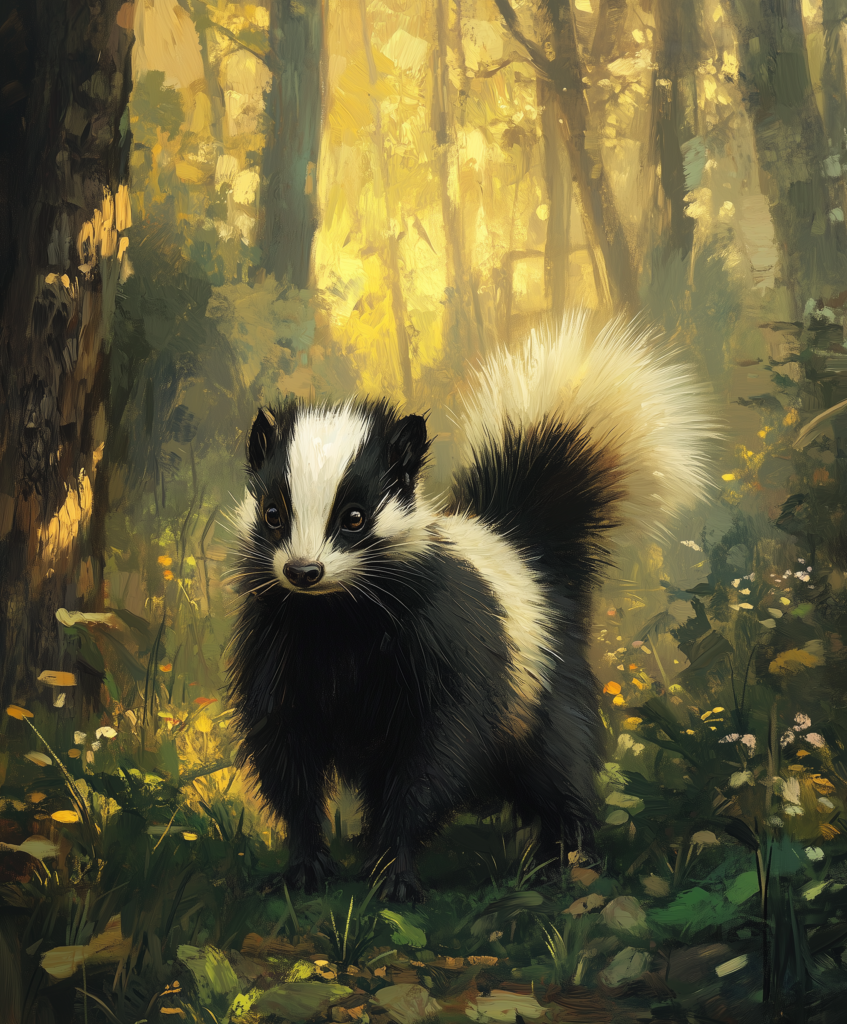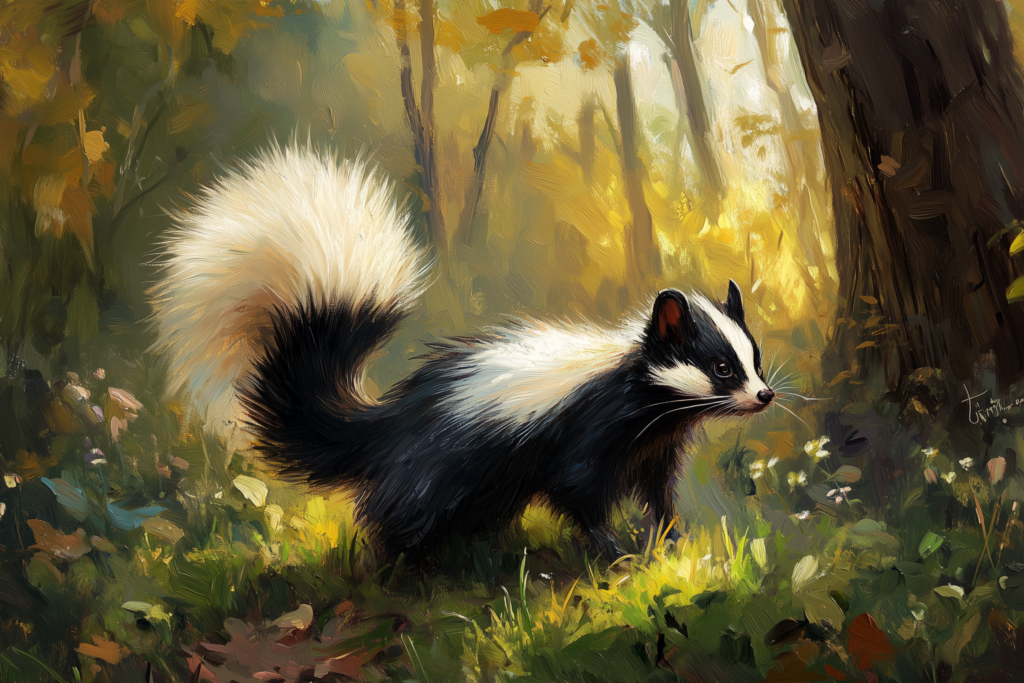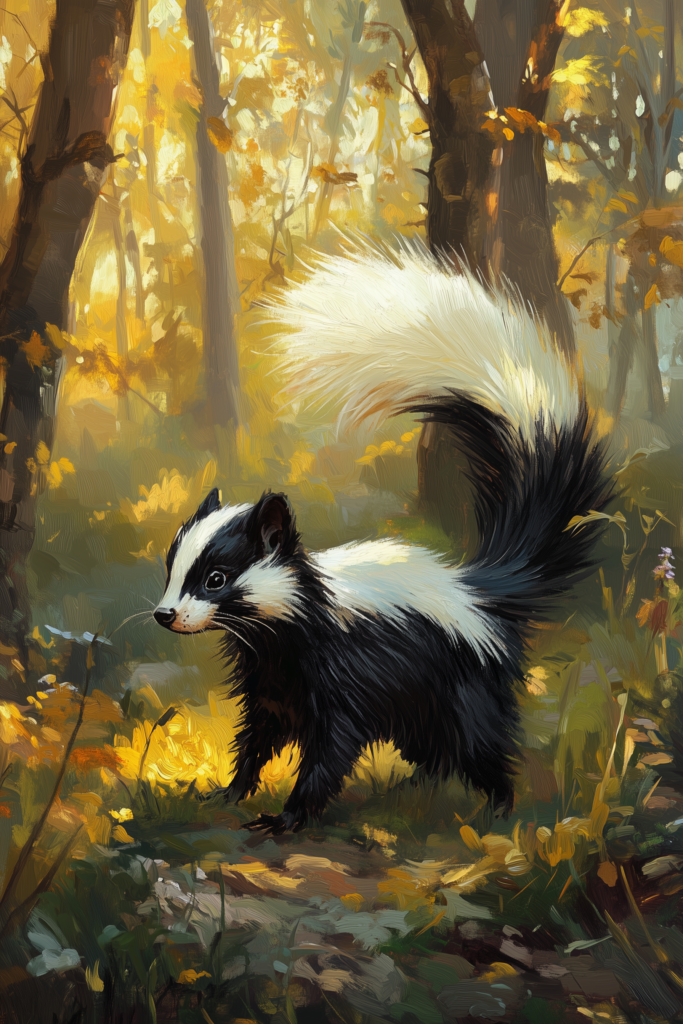“Skunk, The Stench of the Wild”
“This adorable black-and-white critter has a stinky secret that no predator dares to challenge!”

The skunk is a small to medium-sized mammal with a striking black-and-white coat, often featuring bold stripes or spots, and a bushy tail that adds to its distinctive look.
Their most infamous feature is the powerful, foul-smelling spray they release from glands near their tail when threatened, a defense mechanism designed to deter predators from getting too close. Skunks are nocturnal, solitary creatures that prefer to roam alone in search of food, typically insects, small animals, fruits, and plants.
They are highly adaptable, thriving in various habitats, from dense forests and grasslands to suburban areas and urban environments.
Their motivation is simple: survival through foraging and evading predators, with the spray acting as their ultimate deterrent. While generally peaceful, skunks will not hesitate to use their stinky weapon if they feel cornered, making them one of nature’s most effective defensive creatures.
Skunk 5e
Skunk Pathfinder
Skunk

Small Beast, Unaligned
Armor Class 12
Hit Points 18 (4d6 + 4)
Speed 30 ft., Climb 20 ft.
| STR | DEX | CON | INT | WIS | CHA |
|---|---|---|---|---|---|
| 8 (-1) | 15 (+2) | 12 (+1) | 2 (-4) | 14 (+2) | 6 (-2) |
Skills
- Perception +4
- Stealth +6
Senses
- Darkvision 30 ft., Passive Perception 14
Languages
- None
Challenge
- 1/4 (50 XP)
Traits
Keen Smell
The skunk has advantage on Wisdom (Perception) checks that rely on smell.
Spray (Recharge 5–6)
As an action, the skunk can release a foul-smelling spray in a 15-foot cone. Each creature in that area must succeed on a DC 12 Constitution saving throw or be blinded and poisoned for 1 minute. A creature can repeat the saving throw at the end of each of its turns, ending the effect on itself on a success. A creature that succeeds the saving throw is immune to the skunk’s spray for 24 hours.
Nimble Escape
The skunk can take the Disengage or Hide action as a bonus action on each of its turns.
Actions
Bite
Melee Weapon Attack: +4 to hit, reach 5 ft., one target.
Hit: 2 (1d4) piercing damage.
Disorienting Tail Flick
Melee Weapon Attack: +4 to hit, reach 5 ft., one target.
Hit: The target must succeed on a DC 12 Constitution saving throw or be distracted until the end of its next turn. While distracted, the target has disadvantage on attack rolls and ability checks that require concentration.
Tactics
A skunk is an elusive and defensive fighter, relying on its speed and agility to outmaneuver foes rather than engaging in direct confrontation. It will try to avoid combat if possible, using its Nimble Escape to stay out of reach and retreat into cover.
- Start of Combat: The skunk’s first priority is to use Spray to incapacitate any foes in a 15-foot radius, particularly if multiple creatures threaten it at once. It will then attempt to retreat to a safe position or hide using Nimble Escape.
- In Close Quarters: If forced to engage in melee, the skunk will use its Disorienting Tail Flick to create a moment of distraction, lowering the enemy’s effectiveness. It will then try to bite weak points for a quick escape.
- If Cornered: If trapped, the skunk will use Spray as a last resort, followed by immediate flight or hiding to avoid further conflict.
Environmental Tactics
- In a Forest: The skunk uses trees and underbrush for cover, relying on its Stealth to remain unseen. It will retreat up trees to escape foes that are too close.
- In Urban Environments: In tight, urban spaces, the skunk may use alleys and cluttered areas to dart between obstacles. Disorienting Tail Flick could be used against foes in confined spaces, buying it time to escape or hide.
Motivation
The skunk is primarily driven by self-preservation and will avoid combat unless absolutely necessary. Its Spray is a last-ditch effort to neutralize threats, and it will quickly retreat to safety once the danger has passed.
Description
The skunk, known for its distinctive black and white fur, is a small, nocturnal creature often found in forests, fields, and urban areas. Its large, bushy tail is iconic, but it is the skunk’s unique ability to spray a noxious scent that serves as its main defense mechanism. When faced with danger, the skunk will use its keen sense of smell to assess threats and retreat quickly. Its body language is often cautious, and it seeks to avoid direct conflict, preferring stealth and quick escapes.
Skunk

Built like a small badger, this creature has black fur with white stripes running from its face to its fluffy tail, which is raised in warning.
These small mammals are well known to humanoids and forest creatures alike, with their distinctive black-and-white-striped markings and infamous scent glands. Creatures like big cats or wolves that normally would make a meal of such a small creature give skunks plenty of space, for they have learned well that the combination of black and white on a skunk’s back equates to a hideously overpowering stench.
Skunk CR 1/4
XP 100
N Tiny animal
Init +2; Senses low-light vision, scent; Perception +5
DEFENSE
AC 14, touch 14, flat-footed 12 (+2 Dex, +2 size)
hp 3 (1d8-1)
Fort +1, Ref +4, Will +1
OFFENSE
Speed 30 ft.
Melee bite +4 (1d3-4), 2 claws +4 (1d2-4)
Ranged spray +4 touch (musk)
Space 2-1/2 ft.; Reach 2-1/2 ft.
Special Attacks musk
STATISTICS
Str 3, Dex 15, Con 9, Int 2, Wis 12, Cha 6
Base Atk +0; CMB +0; CMD 6
Feats Weapon Finesse
Skills Perception +5
SPECIAL ABILITIES
Musk (Ex)
Up to twice per day, a skunk can spray a stream of noxious musk at a single target within 10 feet as a standard action. With a successful ranged touch attack, the creature struck by this spray must make a DC 11 Fortitude save or be nauseated for 1d4 rounds and then sickened for 1d4 minutes by the horrific stench. A successful save reduces the effect to only 1d4 rounds of being sickened. A creature cannot use the scent ability as long as it is affected by this musk. The save DC is Constitution-based, and includes a +2 racial bonus.
ECOLOGY
Environment temperate forests
Organization solitary, pair, or surfeit (3-5)
Treasure none
Section 15: Copyright Notice
Pathfinder Roleplaying Game Bestiary 3, © 2011, Paizo Publishing, LLC; Authors Jesse Benner, Jason Bulmahn, Adam Daigle, James Jacobs, Michael Kenway, Rob McCreary, Patrick Renie, Chris Sims, F. Wesley Schneider, James L. Sutter, and Russ Taylor, based on material by Jonathan Tweet, Monte Cook, and Skip Williams.

 Buy me a coffee
Buy me a coffee